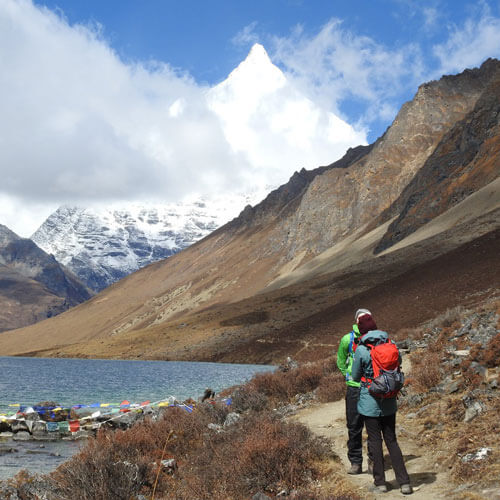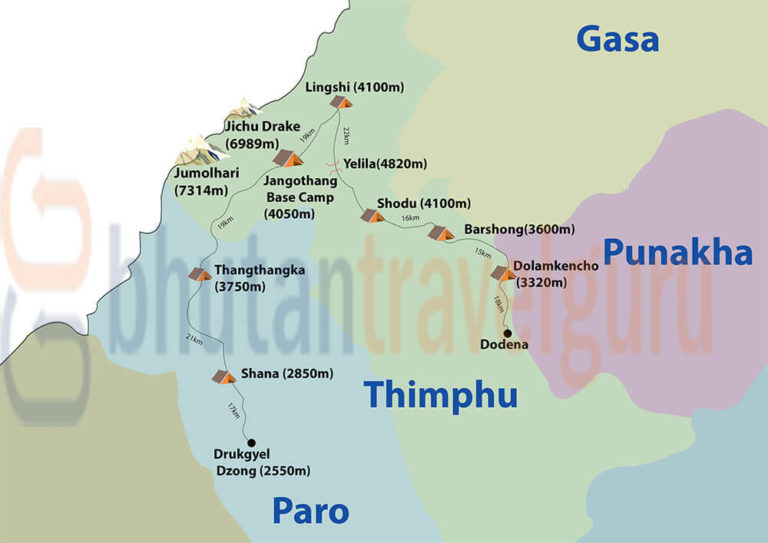Jumolhari Trek

Overview
Trekkers go to the base of Mt. Jumolhari, Bhutan’s most deeply venerated peak on the border of Bhutan and the Tibet region of China. Jumolhari Trek is the most popular trekking route in Bhutan and offers a wide range of landscapes, fauna and flora. The highlight of this trek is the spectacular view of Mount Jumolhari from Jangothang basecamp.
11 Days/10 nights
From US $2880/person

Duration
11 Days

Group Size
2 & above

Trek grade
Moderate/Hard

Accommodation
Hotels/Camping

Avg. Walking Dist.
20 Km

Best season
Mar-May
Sep-Nov

Avg. Walking Time
7 Hours

Max. Elevation
4900m
Tour highlights
- Enjoy the beauty of the snowcapped Jumolhari mountain on your trek.
- Panoramic views of Mount Jichu Drake and Tshering Gang.
- Trekking to the high pass of Nylie La at 4,830m and Yeli La at 4,820m.
- Walk past rhododendron, blue pine, birch and conifers forests
- Chance to see high altitude lakes and Yak Herder's camps.
- Hike to Taktshang Monastery prior to your trek.
Itinerary
Welcome to the Land of Thunder Dragon. On arrival at Paro airport, you will be greeted by our guide and take you to one of the restaurants for lunch. After lunch, you will visit the Rimpung Dzong, dating back to the 17th century. This building is an ancient fortress and center of civil and religious government in the Paro valley. From the Dzong, you can walk down to the road head crossing a traditional wooden bridge. From here, you will be taken to Kichu Lhakhang, one of the oldest and the most sacred shrine in the country. In the evening, you can stroll in Paro town. Overnight hotel in Paro.
5Km | 4-5 hours | 900m Ascent
After breakfast, hike to Taktsang (Tiger’s Nest) Monastery, Bhutan’s most famous monastery, which stands at 3180m gives you acclimatization for the next day’s trek. According to the legend, it is believed that Guru Rimpoche, the 8th century Spiritual Master, flew to this location on the back of a tigress to meditate. Explore the Monastery and hike back to Paro. Overnight hotel in Paro.
17Km | 5-6 hours | 300 Ascent | Camp altitude 2850m
The trek starts from the ruins of Drugyal Dzong at 2300m with a downhill walk on a wide trail. The trail climbs gently traversing through well-maintained rice terraces and fields of millet. The route later enters an area of apple orchards and forests. Soon the valley widens and you reach Gunitsawa village where you pass the army post. The campsite is on the opposite side of the river, not far from Gunitsawa. Camp at an altitude of 2850m.
21Km | 6-7 hours | 900 Ascent | Camp altitude 3750m
On this long day, the trail continues with lots of small ups and downs. After going uphill through the river valley the valley finally narrows gradually to a mere path, which descends to a meadow where a camp will be set up at the altitude of 3750m. From here, if weather permits, you will have the first great view of Mt. Jumolhari.
19Km | 4-5 hours | 300 Ascent | Camp altitude 4050m
This morning the trek continues up the Paro Chhu valley, which widens into patches of alpine meadow and scanty growths of forest. You will cross an army checkpoint along the way and enjoy a spectacular view of high mountain ridges and snow-capped peaks. In this area, yaks and their herder’s homes become a regular feature of the landscape. Passing the villages Sio, Takethang and Dangochang is another asset on this day. After reaching Jangothang, one of the most beautiful campsites of the Himalayas, you will again have a spectacular view of Mount Jumolhari and Jichu Drake.
The rest day in Jangothang provides plenty of possibilities for day hikes with great views of lakes and snow capped mountains such as Jumolhari and Jichu Drake. There are good chances to spot some blue sheep on the upper slopes of the valley. Jangothang is a perfect environment for your acclimatization. You can also trek up to Tsophu Lake or hike around the area.
19Km | 6-7 hours | 800 Ascent | 730 Descent | Camp altitude 4100m
The trail follows the stream or half an hour and crosses the bridge to the right side. Start the climb up to the first ridge with a breathtaking view of Jumolhari, Jichu Drake and Tshering Gang. Then walk towards the valley, almost flat for a while, until the climb to the Ngye La pass at an altitude of 4830m. After the pass, it is a gradual descent to the Lingshi camp, enjoying the panoramic view of the peaks and Lingshi Dzong.
22Km | 8-9 hours | 940 Ascent | 920 Descent | Camp altitude 4100m
The Laya Gasa route leaves the Jumolhari trek here. The trek route climbs towards a small white Chorten on a ridge above the camp, then turns south up the deep Mo Chhu valley. The trail stays on the west side of the largely treeless valley, climbing steadily a short distance above Mo Chhu. It then crosses the river, and climbs steeply for two hours to Yeli La pass (4,820m). From the pass, on a clear day, you can see Jumolhari, Gangchen Ta, Tsheringang and Masangang. The trek from the pass to the campsite at Shodu is a steep downhill.
23Km | 8-9 hours | 700m Descent | Camp altitude 3400m
Today you will come back to the tree line. The path follows the Thimphu River, descending through rhododendron, juniper, and other alpine forests. You will be able to see stunning views of rocky cliffs and waterfalls. You can rest by the riverside and enjoy a hot meal. After lunch, you will gradually ascend to the ruins of Barshong Dzong. Continue to your campsite near a river, Domshisa, which is at 3,400m. Overnight stay at the campsite.
17Km | 5-6 hours | 1080m Descent
The trail descends gently through a dense forest of rhododendron, birch, and conifers and then ascends till you meet the dirt road. Walk along the dirt road for a while, and then you will be picked up. You might spot the Langur monkeys on the trees afar. Dodena is the exit point of Jigme Dorji National Park, and it opens up to the main road that drives to Thimphu. Thimphu is the capital of Bhutan and one of the modern cities there. After some refreshment and a shower, you can stroll around the town of Thimphu. As a memory of your remarkable travel to Bhutan, you can go to the street and buy some souvenirs to take back home for yourself and your loved ones. Overnight stay at hotel.
In the morning, you will drive to airport for departure. Safe journey.
Route Map

Payment
conditions
COST INCLUDES
- Sustainable Development Fee (SDF)
- Accommodation
- All meals
- Transport
- All internal taxes & charges
- Licensed Bhutanese Tour Guide
- Equipment & haulage for trekking tours
COST EXCLUDES
- Flight tickets
- Insurance
- Drinks and Beverages
- Tips
- Internet and Phone bills
- Other bills of personal nature
INSURANCE
Package does not include insurance of any kinds, and that you are required to obtain separate coverage from your home country before your trip begins.
Interested in this trip?
Related tours
Copyright © Bhutan Travel Guru - All Rights Reserved.
